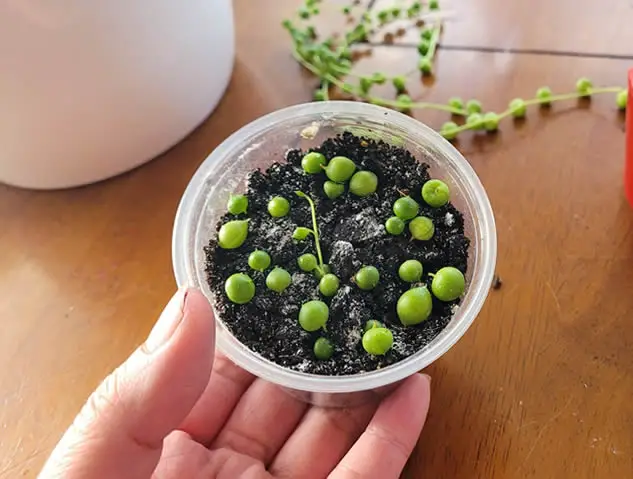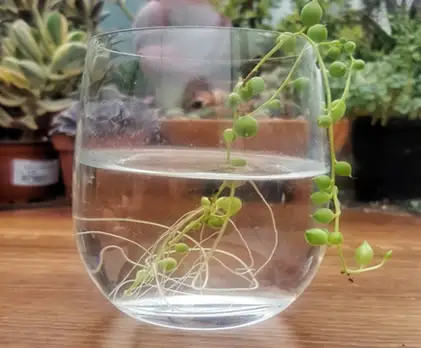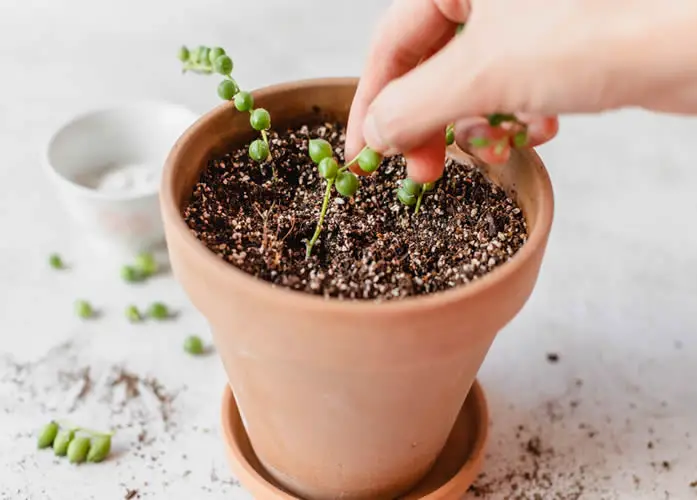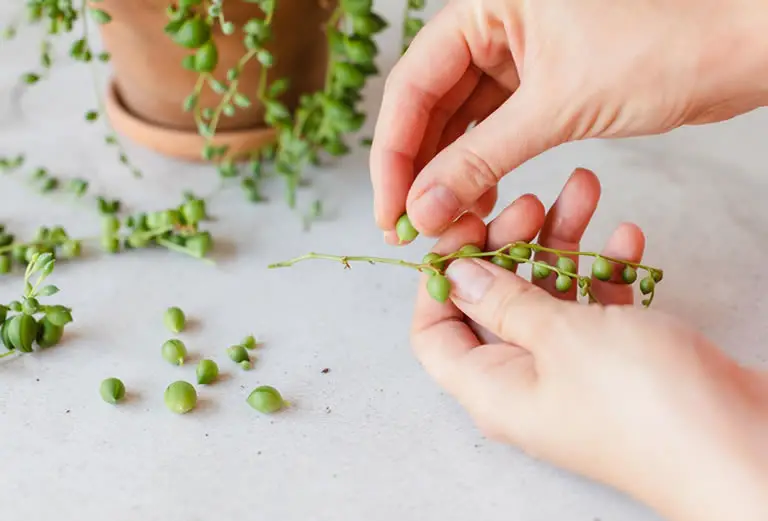String of Pearls might look delicate, but when it comes to propagation, it’s surprisingly easy and forgiving. Whether you’re rescuing a sparse strand, trimming a plant that’s grown too long, or just can’t get enough of those bead-like leaves—this succulent is one of the easiest to multiply.
With a few snips and a little patience, you can grow new cascading strands in no time. And the best part? Every method is beginner-friendly and super satisfying.
Let’s walk through all the ways to propagate String of Pearls—indoors, outdoors, in soil, or even in water.
Table of Contents
- Why String of Pearls Is So Easy to Propagate
- Soil Propagation: The Fastest and Most Reliable Method
- Water Propagation: A Fun, Decorative Option
- Propagation from Fallen Pearls: Yes, It’s Possible
- Outdoor Propagation: Works Well in Warm, Dry Climates
- Best Time to Propagate
- How to Care for Newly Rooted Cuttings
- Final Thoughts
Why String of Pearls Is So Easy to Propagate
Each “pearl” on the vine is a potential root point.
The plant naturally wants to spread and root wherever it touches soil, so propagation is more about guiding that instinct than forcing anything.
Because of this, cuttings root quickly, and you can even use propagation as a way to fill out sparse planters or revive a tired mother plant.
Soil Propagation: The Fastest and Most Reliable Method
This is the go-to method for most people and works beautifully for starting fresh strands or filling out a pot.

Here’s how to do it:
-
Use clean scissors to take a healthy cutting about 4–6 inches long.
-
Gently remove the pearls from the bottom inch or so of the stem—this is where roots will grow.
-
Lay the cutting on top of well-draining succulent soil, or tuck the bare section just beneath the surface.
-
Mist the soil lightly every few days to keep it barely moist (not soggy).
-
Once roots are established (usually within 2–3 weeks), switch to regular succulent watering.
You can plant multiple cuttings in a spiral pattern or layer them in a circle to create a fuller, bushier plant.
Water Propagation: A Fun, Decorative Option
While soil is generally better, water propagation is a fun way to observe the rooting process—plus, it looks great in a glass jar.

To propagate in water:
-
Take a healthy 4–6 inch stem cutting and remove the bottom pearls.
-
Place the cutting in a jar with only the bare stem submerged—avoid soaking the pearls.
-
Set the jar in bright, indirect light.
-
Change the water every few days to keep it clean.
-
Once roots reach 1–2 inches long, transfer the cutting gently to soil and water sparingly.
This method is a bit slower and more delicate during transplant, but it’s fun to watch.
Propagation from Fallen Pearls: Yes, It’s Possible
Accidentally knocked off a few pearls? Don’t throw them away just yet.
While not as reliable as stem cuttings, individual pearls can sometimes root.
To try this:
-
Lay the pearl on moist, well-draining soil.
-
Mist occasionally and provide bright, indirect light.
-
If successful, a tiny root and shoot will form—but this takes longer and isn’t guaranteed.
Still, it’s worth a try if you’re already propagating!
Outdoor Propagation: Works Well in Warm, Dry Climates
If you live in USDA zones 9–11 or are growing String of Pearls outdoors during the warmer months, you can propagate cuttings directly in your garden or container setup.
Here’s how:
-
Snip healthy cuttings and remove the lower pearls.
-
Lay or tuck the stems into well-drained soil in a shaded or dappled light area.
-
Mist occasionally until roots form—avoid watering heavily at first.
-
Once rooted, the plant will begin trailing naturally and can be cared for just like the original.
Outdoors, cuttings tend to root quickly with warmth and airflow, making this a great seasonal propagation option for gardeners in the right zones.
Best Time to Propagate
The ideal time to propagate String of Pearls is during spring and summer, when the plant is actively growing.

This gives the cuttings the best chance to root quickly and grow strong.
Avoid propagation in the cold months, when the plant slows down and is more prone to rot.
How to Care for Newly Rooted Cuttings
Once your cuttings are rooted, treat them like any other succulent:
-
Keep them in bright, indirect light.
-
Water only when the soil is completely dry.
-
Avoid fertilizing for the first month, then feed lightly during the growing season.
Rooted cuttings will often start producing new pearls and trailing vines within a month or two. Use a cacti fertilizer, like this one, to avoid adding excess nutrients to the soil which can hinder the growth of succulents.
With a little time, they’ll become as lush and full as the mother plant.
Be sure to read our article How to Care for String of Pearls (Senecio rowleyanus): A Trailing Succulent That’s Anything but Ordinary for more detailed care instructions.
Final Thoughts
String of Pearls propagation is one of the easiest and most fun ways to grow your succulent collection.
Whether you’re snipping strands to fill a pot, starting fresh plants to give as gifts, or rescuing a sparse vine, this process is simple, fast, and incredibly rewarding.
Let me know if you’d like this turned into a step-by-step visual or printable care sheet—I’d be happy to help you style it up for your blog or socials!

